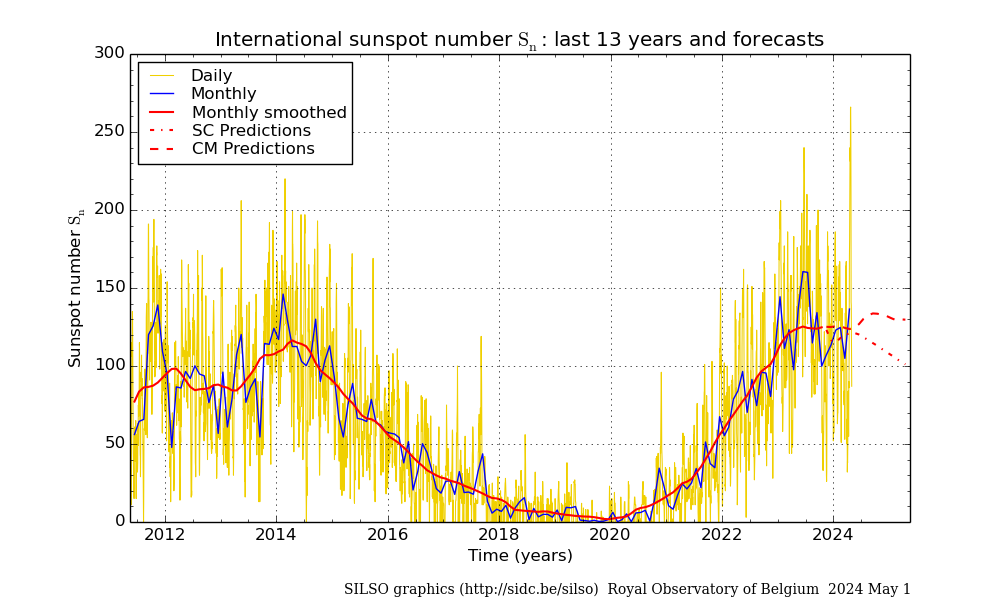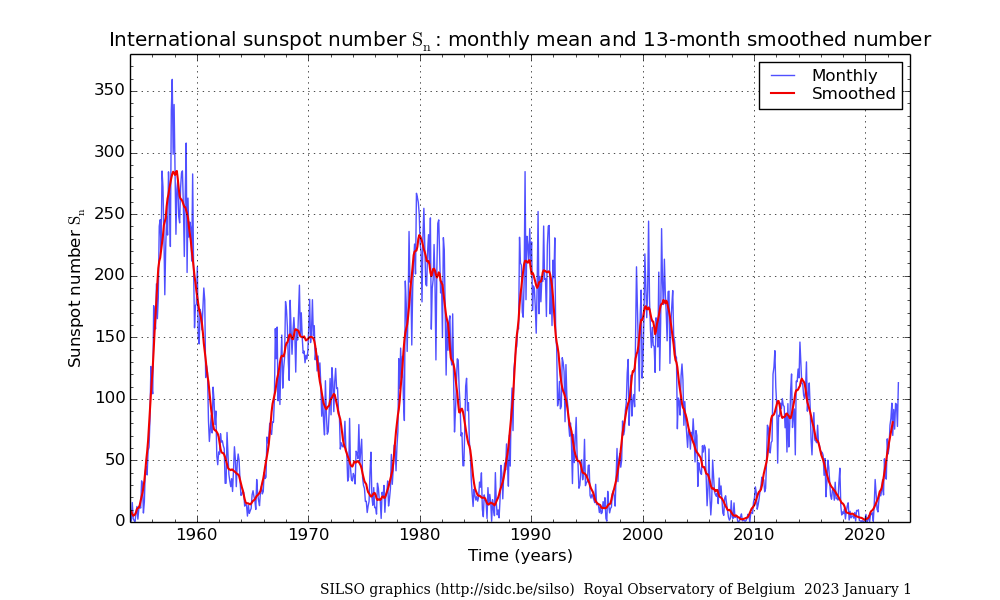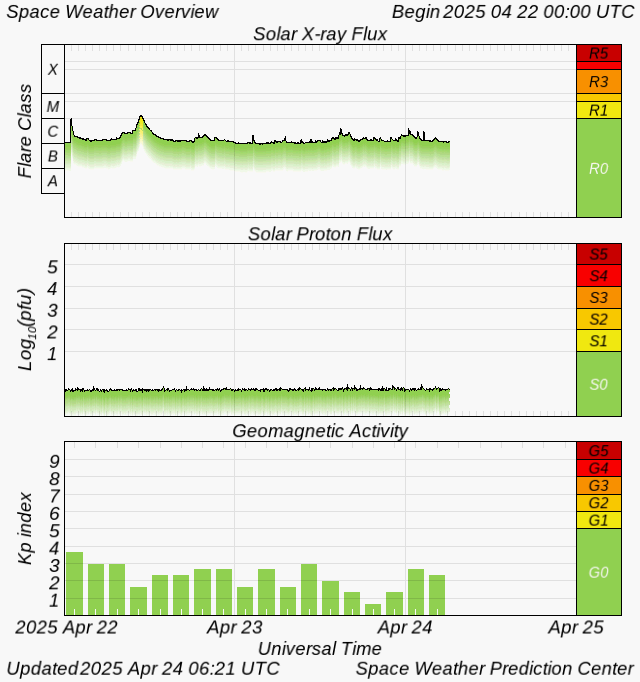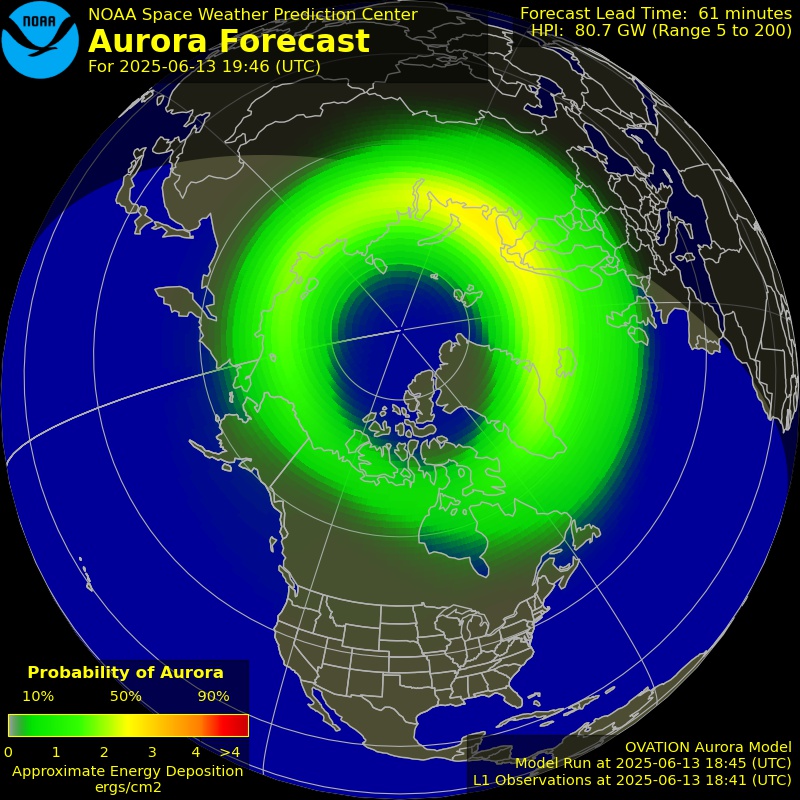Space Weather
Flux, Sunspots, Aurora
Space Weather
The interaction between the solar wind and Earth’s magnetic field
Solar Indices & Geomagnetic Activity
The Sun is the centre of our solar system and the source of energy for life on Earth.  With its thermonuclear fusion in its core, it dissipates particular and electromagnetic radiation. The Sun with its radiation, also called the solar wind, have an enormous effect on the Earth. The solar wind can affect different technologies on Earth, like degrade or block high-frequency radio waves, penetrate satellite electronics and cause an electrical failure, degrade power grid operations or produce the aurora borealis.
With its thermonuclear fusion in its core, it dissipates particular and electromagnetic radiation. The Sun with its radiation, also called the solar wind, have an enormous effect on the Earth. The solar wind can affect different technologies on Earth, like degrade or block high-frequency radio waves, penetrate satellite electronics and cause an electrical failure, degrade power grid operations or produce the aurora borealis.
The interaction between the solar wind and Earth’s magnetic field and the influence of the underlying atmosphere and ionosphere creates various regions of fields, plasmas, and currents inside the magnetosphere such as the plasmasphere, the ring current, and radiation belts. The consequence is that conditions inside the magnetosphere are highly dynamic and create what we call “space weather”. That can affect technological systems and human activities.
Solar Cycle Sunspot number
Sunspots are an area seen as a dark spot, in contrast with its surroundings, on the photosphere of the Sun. The sunspot number is the daily index of sunspot activity. The sunspot cycle is the approximately 11-year quasi-periodic variation in the sunspot number. The polarity pattern of the magnetic field reverses with each cycle. The number of sunspots has a major effect on shortwave, mediumwave and VHF communication.


SOLAR CYCLE 10,7 cm RADIO FLUX
The 10,7 cm radio flux (2800 MHz) is a radio wave emission of the sun and is in relation to the sunspot number. The value of the radio flux level has a major effect on shortwave, mediumwave and VHF communication. A higher level of solar radio flux improves shortwave radio communication. The F10.7 radio emissions originate high in the chromosphere and low in the corona of the solar atmosphere.
REALTIME K INDEX, X-RAY & PROTON FLUX

SOLAR X-RAY FLUX
The GOES X-ray flux plot contains one minute averages of solar X-rays in the 1-8 Angstrom (0.1-0.8 nm) and 0.5-4.0 Angstrom (0.05-0.4 nm) passbands. Large X-ray bursts cause short wave fades for HF propagation paths through the sunlight hemisphere.
SOLAR PROTON FLUX
Solar Proton Events at Earth can occur throughout the solar cycle but are most frequent in solar maximum years. SPEs are high-energy particles and results from fast coronal mass ejections. In addition, these high energy particles can access the polar ionosphere and create an enhanced region of ionization (called the ‘D-Region’) which interferes with HF radio communication in these areas. High-energy particles can reach Earth anywhere from 20 minutes to many hours following the initiating solar event.
GEOMAGNETIC ACTIVITY
Is the 3-hourly quasi-logarithmic local index of geomagnetic activity relative to an assumed quiet-day curve for the recording site. The range is from 0 (quiet) to 9 (severely disturbed). The K index measures the deviation of the most disturbed component.
EUV images of the sun
Images of the extreme ultraviolet wavelength (EUV) radiation of the sun. Observations of solar EUV emission aids in the early detection of solar flares, coronal mass ejections (CMEs), and other phenomena that impact the geospace environment.
Auroral Activity
AURORA BOREALIS

The OVATION (Oval Variation, Assessment, Tracking, Intensity, and Online Nowcasting) model is an empirical model of the intensity of the aurora developed at the Johns Hopkins University, Applied Physics Lab by Patrick Newell and co-workers. The model uses solar wind and interplanetary magnetic field (IMF) conditions at the L1 point, upstream of Earth towards the sun, as inputs. The model produces an estimate of the intensity of the auroral energy at locations on Earth.
The OVATION Aurora Forecast Model shows the intensity and location of the aurora predicted for the time shown at the top of the map.






